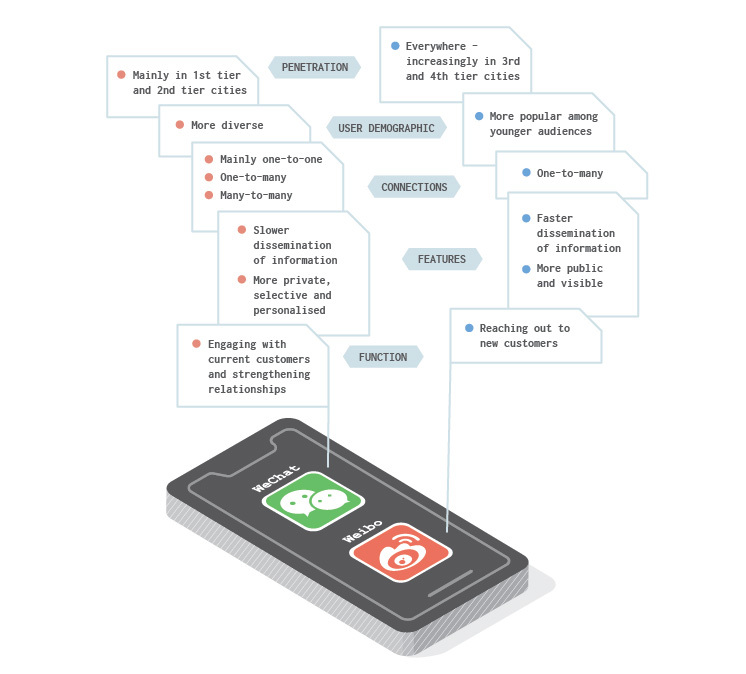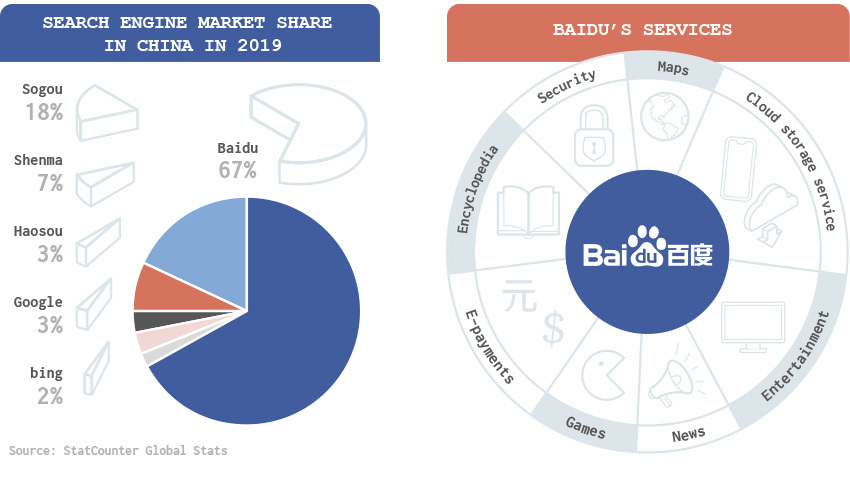China's internet population now stands at 989 million. And, if you are a B2B marketer looking to launch or grow your business in the country, be it in finance, healthcare or technology, you have to go online too, or risk missing out. In China, this usually means building a presence on WeChat, Weibo and Baidu.
It is well-known that China’s policy to keep out foreign social media platforms such as Facebook, Instagram, Twitter and YouTube, has helped the growth of these homegrown social networking tools, which have since become household names in the country.
While most people will have heard of these channels using them effectively as a marketing tool is a different question altogether. So here we explain to our readers their unique characteristics and explain the contexts in which they work well.

This application has come a long way since starting out as a chatting app ten years ago. Its various functions make it an essential tool for marketers in China, especially given that it boasts an average daily active user base of one billion, including among businesses. And its versatility means it can be (and usually is) also used as a branding and CRM tool, a replacement for email and even as a recruitment platform.
You can choose from three types of official accounts: Service Account, Subscription Account and WeChat Work. The first two types are designed to bolster customer service capabilities, while WeChat Work, which is similar to Slack, is an internal communication tool. (Check out N/N’s blog on video conferencing tools for more on this topic.)

Here are some ways you can maximise the effectiveness of your WeChat profile.
Display WeChat QR codes prominently: Make your WeChat QR codes as noticeable as possible by placing them on your website, email newsletters, marketing flyers, and even business cards. This will direct customers to your official account and increase traffic.
Message settings: Set up the system so users can instantly receive acknowledgments and updates once they follow your account, or when they send you a message. Updates will depend on the account type.
Post appealing content: The average user spends 77 minutes every day on WeChat. Make sure that your content is engaging and informative and makes the most of this screen time by regularly promoting your content in short, social media-friendly posts.
Here is an example of how Chinese healthcare platform Shuidi Huzhu, a healthcare crowdfunding platform, uses its Service Account:
- Featured content of varying lengths and formats, ranging from news snippets to case studies, to serve a range of preferences
- E-commerce interface (just like B2C brands) providing full descriptions of its insurance products
- CRM feature that allows clients to talk to customer service representatives
The microblogging service is known for its focus on trending topics, celebrity news and brand promotions. Nearly every industry in China, including financial services, healthcare, construction, manufacturing, food and beverage, luxury goods – uses it to engage their customers.
In order to do that, it’s crucial to establish the legitimacy of your business on the platform by acquiring the verification badge – much like Twitter’s check mark. Orange is for individuals while blue is reserved for companies.
Here are two examples: American software company Citrix’s Weibo page, which currently has more than 1.4 million followers and Philips Healthcare’s Weibo page with more than 1.7 million followers. Both feature a wide array of content, including articles, photos, videos, graphics and memes in relation to its services, to appeal to decision makers. It also advertises special offers and hosts webinars to keep followers engaged on the platform.
You can find more information about account verification here.
What’s the difference
Choosing between WeChat and Weibo is a difficult decision. They differ from each other mostly in terms of privacy settings and distribution formats. But, on balance, Weibo may be a better option to gain exposure for brands that are just starting out in China.

Baidu
In China where Google’s reach is limited, Baidu is widely considered the go-to search engine. Baidu Tuiguang, the giant’s Pay-per-click (PPC) platform, much like Google Ads, puts ads alongside its search results and is a good bet for B2B marketers to attract attention and generate leads.

To ensure that your efforts are paying off, you should keep refining your content strategy with the help of tools like Baidu Keyword Planner and Baidu Analytics. Baidu’s Keyword Planner is similar to Google Ads Keyword Planner, in analysing search traffic trends. Baidu Analytics, also known as Baidu Tongji, keeps track of online statistics, including the number of visitors to your website, their activities and duration of visit, and provides tips on search engine optimisation (SEO).
Hearts and minds
As competition for the Chinese consumer’s attention continues to heat up, those who want a piece of market share in the world’s second-largest economy should begin thinking about the tools that can help them build and solidify their brand identity in China. And, these three tools are good places to start.
For more on China’s social media landscape read: Managing B2B content on China’s social media platforms.
World-class content strategy and execution
Contact us to get started